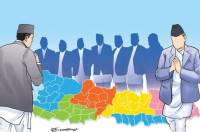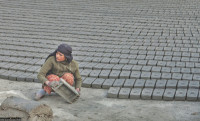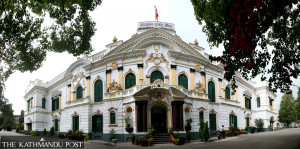Columns
‘Storytelling’ worth the name
Weekend supplements, which previously showcased impressive storytelling, are now gradually disappearing.
Dharma Adhikari
Not infrequently these days, audiences burst out on social media. They get irritated by the types of news contents shoveled out on them. A recent source of annoyance to some was a grandiloquent-looking narrative on the wedding of a nouveau political princeling class. Others find it off-putting to read puff pieces on celebrities (foreign and, occasionally, local) or partisan rants masquerading as long-form reportage.
All the more, our outlets often become targets of audience rage for their premature headlines, misleading “leads”, missing angles, unsourced or poorly attributed reporting, mischaracterised facts or details, rampant personification, wildly incomplete reporting, lack of follow up, recycled junk and more.
Regardless of the nature of the beast, the great lure—and the race—for “storytelling” continues. Amidst growing digital distractions, news outlets desperately seek not only your attention but also your loyal engagement, and so the moniker “storytelling” is more pronounced these days. Outlets are ever pressed to outdo their competitors.
The question is, how much storytelling are our outlets doing? Certainly, “storytelling” without the story places an undue emphasis on the word—not on its meaning, nor on its substance.
News vs storytelling
Journalists use “news” and “story” or “news story” interchangeably, although news has little to do with a story, in its literal sense, particularly in the case of “hard news.” These news articles are often brief and to the point, focusing on the who, what, where, when and why of events. At their core, they are a stickler for facts, details and quotes about something new happening, presented in a neutered voice. They are deficient in narrative elements—a clear and strong chronology, characters, point of view, or resolution—to be called a story.
News is shaped by what journalists call “newsworthiness”, or “news values”, that determine what gets reported and how. To this effect, some editors like to cite the rhymes by the English Restoration poet Alexandar Pope, paraphrased thus: We tell of love, war, health, death, loss, famine, storms, and portents, all neither wholly false nor wholly true…. News, then, is not without flaws.
A critical tension exists between news values and the ideals of journalism. While news values often prioritise sensationalism, bad news and even oddities, the core principles of journalism, which gained true currency during the early 20th century, emphasise accuracy, truth-seeking, honesty, and integrity, among others.
In our context, news values like negativity, conflict, human interests, prominence, proximity, and unusualness appear dominant. Also, among the vernacular news drivers are conspiracies and national interests (sometimes bordering on jingoism), while consequence or impact seem lost in the shuffle.
Journalistic principles may also transcend professional norms, reflecting cultural values. Nepali journalism’s traditional bias for subjectivity persists, despite its general embrace of the objectivity model emphasising “hard news.” Also, it seems acceptable and even enticing for many Nepali journalists to be themselves in the news, to project their points of view.
In our region, traditionally, samachar has a more positive connotation. It traces its roots in Sanskrit, to performance, virtuous or proper conduct, tiding, or simply news or report, more specifically about the health of family or friends: Sanchai hunuhunchha? (how are you feeling?) Halkhabar ke chha? (what’s up?). Whatever our cultural inclinations, the pursuit of detached, matter-of-fact reporting becomes elusive if or when news reporters insist on doing storytelling that will require them to weave narrative elements, unsuccessfully, into hard news pieces.
This was equally true in the West until the mid-1950s. If newspapers had to address their existential threat during that golden era of television, something had to be tried: Storytelling to connect emotionally with the readers. It was then that the industry saw the birth of the genre called feature article, or soft news, as a supplement to hard news. In Nepali, it is variously described as aalekh or lekh (record, write up), but the English word “feature,” “feature lekh” and “feature story” are more popularly used.
Dislocation
Once again, the emergence of new media and further market segmentations have led to a massive dislocation of traditional journalism, placing stupendous demands on news professionals. They not only have to grab and retain user attention but also inform and engage audiences who have the luxury of infinite choices.
Storytelling in a feature is achieved through core characters, conflict and resolution in the story told. Narrative elements, such as scene recreation, anecdotes, chronology, dialogue, metaphors, personifications, and voice are sparingly woven into the story.
This juncture, however, demands more than just longish, human-centric and subjective write ups, interspersed with narrative elements. Long forms need mingling with shorts, doing bite-size storytelling to the ever-impatient and insatiable audiences across platforms, in texts, visuals, audios and videos.
In essence, storytelling worth the name remains limited in Nepali journalism, primarily appearing in occasional features, articles, some broadcast programmes and news sites. Weekend supplements, which previously showcased impressive storytelling, are now gradually disappearing. Digital storytelling remains synonymous with embedding or posting YouTube videos and tweets, with a few exceptions in visualisation. Innovations in forms such as immersive, data-driven, collaborative, and Generative AI-powered storytelling are rarely seen.
Some individual journalists and outlets prioritise storytelling to some extent, but the focus appears to be on opinion pieces, commentaries, and discourses. Independent producers on social media are innovating with travelogues, feature interviews and documentaries. While profiles are popular, trend-, problem-, and issue-focused storytelling remain relatively rare. Investigative articles are sporadic and limited in number.
We need more stories that connect the dots, revealing the “bigger picture” through explanatory/enterprise journalism featuring extensive reporting and in-depth research. Essentially, then, it is about factual storytelling, enriched with vivid details. The journalistic principles of accuracy, honesty, and integrity remain paramount.




 9.12°C Kathmandu
9.12°C Kathmandu















